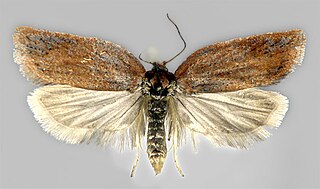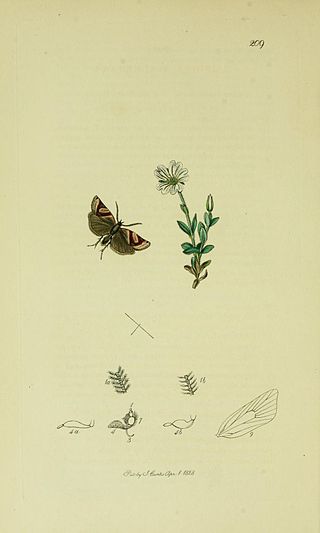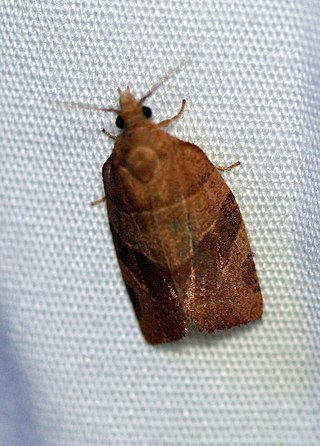
Myrica is a genus of about 35–50 species of small trees and shrubs in the family Myricaceae, order Fagales. The genus has a wide distribution, including Africa, Asia, Europe, North America, and South America, and missing only from Antarctica and Oceania. Some botanists split the genus into two genera on the basis of the catkin and fruit structure, restricting Myrica to a few species, and treating the others in Morella.

Myrica rubra, also called yangmei, yamamomo, Chinese bayberry, red bayberry, yumberry, waxberry, or Chinese strawberry is a subtropical tree grown for its fruit.

Eudemis is a genus of moths belonging to the subfamily Olethreutinae of the family Tortricidae.
Callibryastis is a genus of moths belonging to the subfamily Tortricinae of the family Tortricidae. It contains only one species, Callibryastis pachnota, which is found in Vietnam and India.

The Olethreutini are a tribe of tortrix moths.

Acleris rufana is a moth of the family Tortricidae. It is found from northern, central and south-western Europe through southern Siberia to the Russian Far East and Japan.

Clepsis senecionana, the rustic tortrix, is a moth of the family Tortricidae. It is found from Europe to eastern Siberia.

Philedonides lunana, also known as the heath tortrix and Walker’s Lanark tortrix, is a moth of the family Tortricidae. It was first described by Carl Peter Thunberg in 1784 and is found in most of Europe.
Strepsicrates smithiana, the bayberry leaftier moth or Smith's strepsicrates moth, is a moth of the family Tortricidae. It was first described by Lord Walsingham in 1891. It is native to southern North America, south to South America, including Florida, Texas, Georgia, Dominican Republic, Puerto Rico, Cuba and the Galapagos Islands. It was introduced to Oahu, Hawaii, in 1955 to aid in the control of Myrica faya.
Lyonetia myricella is a moth in the family Lyonetiidae. It is known from Japan.

Cameraria obstrictella is a moth of the family Gracillariidae. It is known from Ontario and Quebec in Canada, and New York, Ohio, Kentucky, Maine, Vermont and Pennsylvania in the United States.
Archips termias, the apple leafroller, is a moth of the family Tortricidae. It is found in Vietnam, India, Nepal and China.
Atsusina is a genus of moths belonging to the subfamily Olethreutinae of the family Tortricidae. It contains only one species, Atsusina curiosissima, which is found in Vietnam.
Sorolopha herbifera is a moth of the family Tortricidae. It is found in Vietnam, India, Sri Lanka, Sumatra, Java and Taiwan.

Choristoneura lafauryana, the strawberry leafroller, is a species of moth of the family Tortricidae. It is found in Spain, Great Britain, the Netherlands, Belgium, France, Germany, Switzerland, Italy, Romania and Russia. In the east, the range extends to China, Korea and Japan.

Homona magnanima, the Oriental tea tortrix moth, is a species of moth of the family Tortricidae. It is found in Japan, Taiwan, China and Vietnam.

Pandemis limitata, the three-lined leafroller, is a species of moth of the family Tortricidae. It is found in North America, where it has been recorded from Nova Scotia to British Columbia and from the east coast west to the Rocky Mountains and Arizona. It has also been recorded from Durango in Mexico.

Acleris lipsiana is a species of moth of the family Tortricidae. It is found in Great Britain, Spain, France, Belgium, the Netherlands, Germany, Denmark, Austria, Switzerland, Italy, the Czech Republic, Slovakia, Hungary, Poland, Greece, Norway, Sweden, Finland, the Baltic region and Russia. It is also found in North America, where it has been recorded from Alberta and Washington. The habitat consists of high moors and mountainous areas.

Metendothenia atropunctana is a moth belonging to the family Tortricidae. The species was first described by Johan Wilhelm Zetterstedt in 1839.

Epinotia caprana is a moth belonging to the family Tortricidae. The species was first described by Johan Christian Fabricius in 1798.












